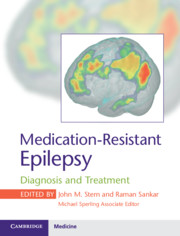Book contents
- Medication-Resistant Epilepsy
- Medication-Resistant Epilepsy
- Copyright page
- Dedication
- Contents
- Contributors
- Chapter 1 The Natural History of Epilepsy
- Chapter 2 Challenges in Identifying Medication-Resistant Epilepsy
- Chapter 3 International League Against Epilepsy’s Definition of Medication-Resistant Epilepsy
- Chapter 4 The Economic Impact of Medication-Resistant Epilepsy
- Chapter 5 Social Consequences of Medication-Resistant Epilepsy
- Chapter 6 Mortality and Morbidity of Medication-Resistant Epilepsy
- Chapter 7 Models for Medication-Resistant Epilepsy
- Chapter 8 Neurobiology of Medication-Resistant Epilepsy
- Chapter 9 Genetic Causes of Medication-Resistant Epilepsy
- Chapter 10 Malformations of Cortical Development as Causes of Medication-Resistant Epilepsy
- Chapter 11 Hippocampal Sclerosis as a Cause of Medication-Resistant Epilepsy
- Chapter 12 Autoimmune Causes of Medication-Resistant Epilepsy
- Chapter 13 Medication-Resistant Epilepsy Syndromes in Children
- Chapter 14 Medication-Resistant Epilepsy in Adults
- Chapter 15 Approach to the Treatment of Medication-Resistant Epilepsy
- Chapter 16 Pharmacotherapy for Medication-Resistant Epilepsy
- Chapter 17 Reproductive Health for Women with Medication-Resistant Epilepsy
- Chapter 18 Resective Surgery for Medication-Resistant Epilepsy
- Chapter 19 Ablative Surgery for Medication-Resistant Epilepsy
- Chapter 20 Stimulation Treatment for Medication-Resistant Epilepsy
- Chapter 21 Diet Therapy for Medication-Resistant Epilepsy
- Chapter 22 Botanical Treatments for Medication-Resistant Epilepsy
- Chapter 23 Psychiatric Comorbidities in Medication-Resistant Epilepsy
- Index
- References
Chapter 19 - Ablative Surgery for Medication-Resistant Epilepsy
Published online by Cambridge University Press: 20 August 2020
- Medication-Resistant Epilepsy
- Medication-Resistant Epilepsy
- Copyright page
- Dedication
- Contents
- Contributors
- Chapter 1 The Natural History of Epilepsy
- Chapter 2 Challenges in Identifying Medication-Resistant Epilepsy
- Chapter 3 International League Against Epilepsy’s Definition of Medication-Resistant Epilepsy
- Chapter 4 The Economic Impact of Medication-Resistant Epilepsy
- Chapter 5 Social Consequences of Medication-Resistant Epilepsy
- Chapter 6 Mortality and Morbidity of Medication-Resistant Epilepsy
- Chapter 7 Models for Medication-Resistant Epilepsy
- Chapter 8 Neurobiology of Medication-Resistant Epilepsy
- Chapter 9 Genetic Causes of Medication-Resistant Epilepsy
- Chapter 10 Malformations of Cortical Development as Causes of Medication-Resistant Epilepsy
- Chapter 11 Hippocampal Sclerosis as a Cause of Medication-Resistant Epilepsy
- Chapter 12 Autoimmune Causes of Medication-Resistant Epilepsy
- Chapter 13 Medication-Resistant Epilepsy Syndromes in Children
- Chapter 14 Medication-Resistant Epilepsy in Adults
- Chapter 15 Approach to the Treatment of Medication-Resistant Epilepsy
- Chapter 16 Pharmacotherapy for Medication-Resistant Epilepsy
- Chapter 17 Reproductive Health for Women with Medication-Resistant Epilepsy
- Chapter 18 Resective Surgery for Medication-Resistant Epilepsy
- Chapter 19 Ablative Surgery for Medication-Resistant Epilepsy
- Chapter 20 Stimulation Treatment for Medication-Resistant Epilepsy
- Chapter 21 Diet Therapy for Medication-Resistant Epilepsy
- Chapter 22 Botanical Treatments for Medication-Resistant Epilepsy
- Chapter 23 Psychiatric Comorbidities in Medication-Resistant Epilepsy
- Index
- References
Summary
Medication-resistant epilepsy continues to be a challenging condition, but numerous medical as well as surgical treatment options developed over the years have added significantly to the therapeutic arsenal of both neurologists and neurosurgeons. One such approach to epileptic patients focuses around physically disrupting their epileptogenic circuitry, with relevant modalities including traditional open surgical resection and radiosurgery, as well as ablation via radiofrequency, cryotherapy or laser interstitial thermal therapy [1–10]. The interest in less-invasive methods for control of medication-resistant epilepsy has been motivated by several factors, including: reducing perioperative morbidity, decreasing length of stay and associated complications/costs, and offering treatments for patients that are otherwise not eligible for traditional surgical resections, be it for reasons related to medical comorbidities or factors inherent to their epileptic pathology. Additionally, the perceived risks of open craniotomy may play a role in limiting both the number of patients referred to tertiary epilepsy centres by primary care physicians, as well as the number of patients willing to undergo traditional open resection, even in the face of significant evidence in support of the safe role of surgery in refractory epilepsy [11]. Stereotactic laser ablation (SLA) is among the most relevant surgical advances in the treatment of drug-resistant epilepsy, offering the benefit of high rates of seizure control in epileptic patients with varying underlying seizure aetiologies, combined with minimization of the amount of normal cerebral tissue disrupted due to the advent of real-time image-guided feedback [3,4,5,8,10,12].
- Type
- Chapter
- Information
- Medication-Resistant EpilepsyDiagnosis and Treatment, pp. 210 - 218Publisher: Cambridge University PressPrint publication year: 2020



